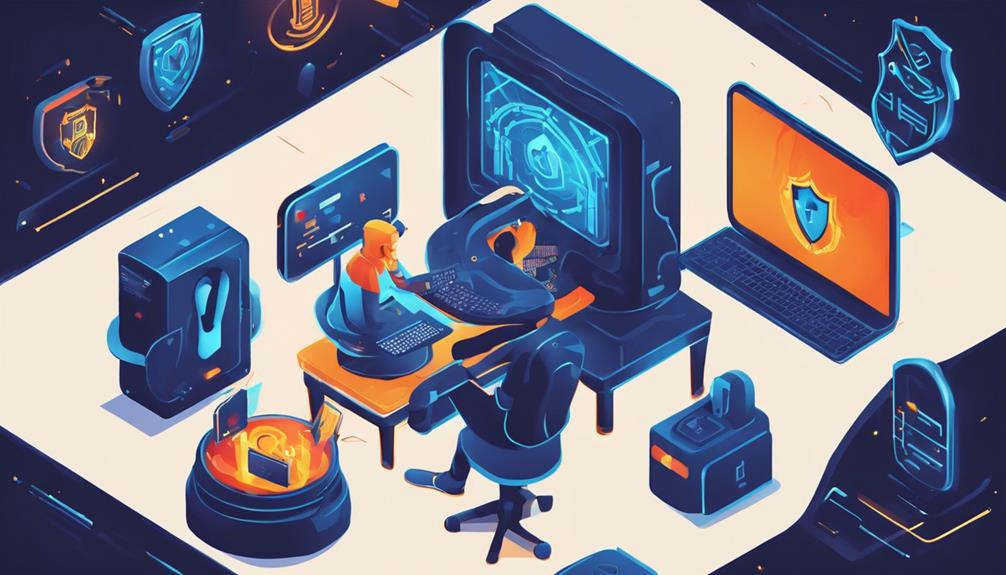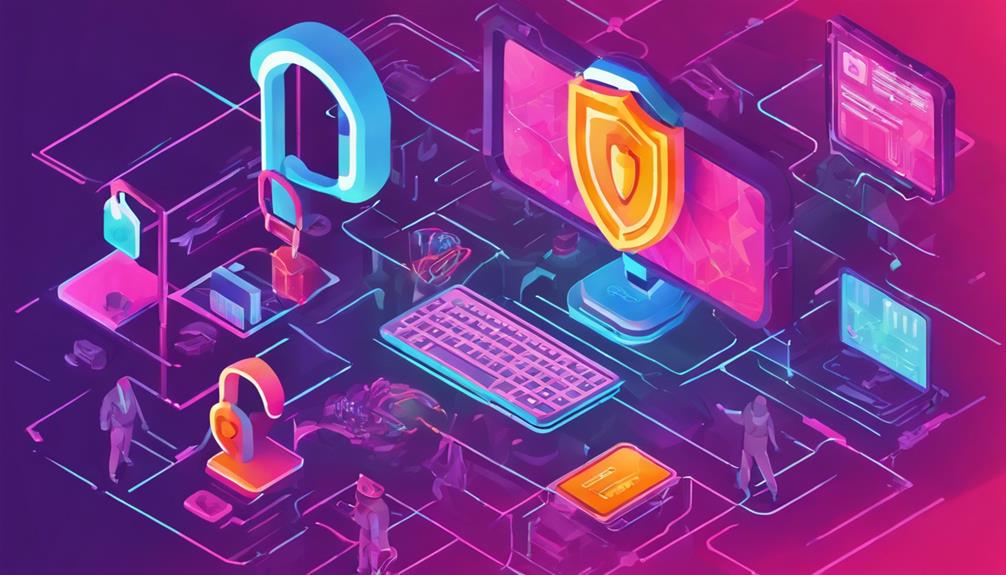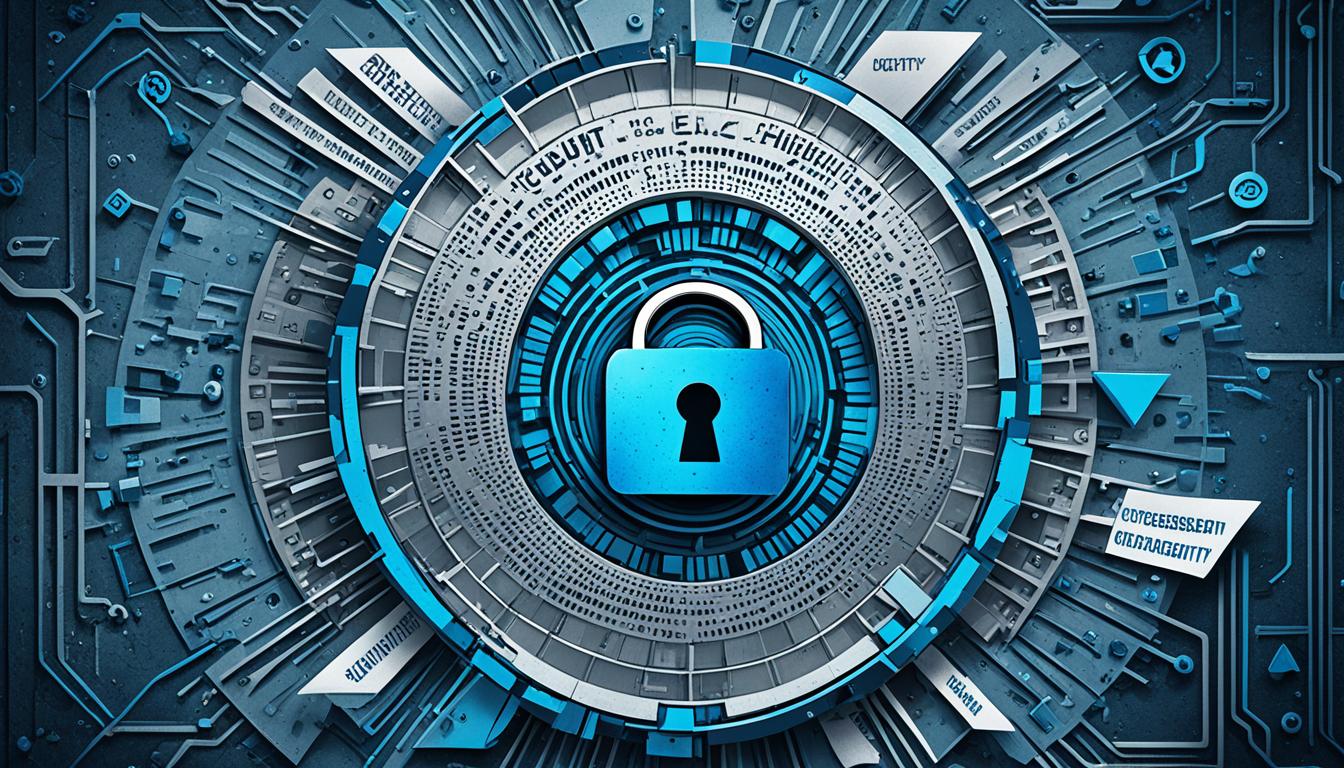To browse safely, beware of deceptive emails with malicious links. Avoid public Wi-Fi for secure data transmission. Be cautious with fake apps that steal personal data. Watch out for tempting links leading to scams. Use strong passwords and two-factor authentication for enhanced security. Regularly update software to defend against cyber threats. Safeguard personal info by adjusting privacy settings and enabling two-factor authentication. Taking these precautions shields you from hackers' tactics.
Key Takeaways
- Use strong passwords and multi-factor authentication.
- Be cautious of tempting links and social engineering tactics.
- Avoid public Wi-Fi for sensitive activities.
- Regularly update software for enhanced security.
- Beware of deceptive emails and fake apps.
Deceptive Emails and Spear Phishing
Hackers employ deceptive emails and spear phishing techniques as a means to illicitly obtain sensitive information from unsuspecting individuals. Deceptive emails often contain malicious links or attachments that, once clicked, can lead to malware installation or data theft. Spear phishing is a form of targeted attack where hackers craft emails that appear legitimate, tricking recipients into divulging confidential data.
Common tactics used in deceptive emails include impersonation strategies, typos to mimic official correspondence, and fake software updates to deceive recipients.
It is essential for individuals to remain vigilant when checking emails, scrutinizing them for signs of phishing attempts, and avoiding clicking on suspicious links or downloading attachments.
Risks of Public Wi-Fi

Public Wi-Fi networks pose significant risks, including data interception and unauthorized access to personal information, making users vulnerable to cyber attacks. Cybercriminals can exploit unsecured public Wi-Fi by setting up fake hotspots to steal sensitive data, emphasizing the importance of cautious browsing practices.
To mitigate these risks, utilizing a virtual private network (VPN) when connecting to public Wi-Fi can encrypt data transmissions and enhance online security, safeguarding against potential threats like man-in-the-middle attacks and packet sniffing.
Public Wi-Fi Dangers
When connecting to public Wi-Fi networks, individuals expose themselves to significant risks of data interception and unauthorized access. Hackers can easily intercept data and sensitive information transmitted over public Wi-Fi, putting personal accounts at risk.
Man-in-the-middle attacks are a common tactic used by cybercriminals on these networks, where they position themselves between the user and the network to steal valuable data.
Moreover, fake Wi-Fi hotspots set up by hackers in public places can lure unsuspecting users into connecting to malicious networks, leading to potential data breaches and privacy violations.
It is advisable to refrain from accessing sensitive information like banking details or personal accounts when connected to public Wi-Fi to prevent unauthorized access.
To enhance security and protect data while using public Wi-Fi, individuals can utilize a Virtual Private Network (VPN) that encrypts data transmissions, making it harder for hackers to intercept and exploit sensitive information.
Secure Browsing Tips
Exercising vigilance and employing proactive security measures are crucial when managing the risks associated with utilizing public Wi-Fi networks. Public Wi-Fi networks are convenient but pose significant security risks as hackers can easily intercept sensitive information like passwords and personal data.
To enhance security while using public Wi-Fi, consider using a VPN (Virtual Private Network) to encrypt your internet connection, making it harder for cybercriminals to access your data. Be cautious of fake Wi-Fi hotspots that mimic legitimate networks to lure unsuspecting users into connecting.
Avoid accessing sensitive information like online banking or shopping while on public Wi-Fi to prevent data theft. Always verify the legitimacy of public Wi-Fi networks by checking with staff or official signage to guarantee a safe browsing experience.
VPN Protection Benefits
Utilizing VPN protection on insecure Wi-Fi networks is essential for safeguarding sensitive data from potential cyber threats. Public Wi-Fi networks are prime targets for cyber attacks, leaving your online activities vulnerable to exploitation.
By encrypting your internet traffic, VPNs create a secure tunnel that prevents unauthorized access on public Wi-Fi, ensuring your privacy and enhancing security. Without VPN protection, hackers can intercept valuable information such as passwords, emails, and financial details easily.
In addition to safeguarding your data, VPNs also mask your IP address, adding an extra layer of security to your online presence. This IP address masking not only enhances your online privacy but also encrypts your connection, making it harder for cybercriminals to breach your sensitive information.
Incorporating VPN protection when connecting to public Wi-Fi networks is essential for maintaining the confidentiality and integrity of your online activities.
Dangers of Fake Apps

Fake apps pose a significant threat to users as they can contain malware or steal personal information. These malicious applications often mimic popular legitimate apps, making it hard for users to distinguish between the two. Fake apps specifically target sensitive data such as login credentials, credit card details, and personal information.
To mitigate the risks associated with fake apps, users are advised to download apps solely from official app stores like Google Play Store or Apple App Store. Additionally, regularly reviewing app permissions and conducting thorough research on app developers can help users identify and avoid fake apps effectively.
Tempting Links and Social Engineering

Beware of the deceptive tactics employed by hackers through tempting links and social engineering strategies to exploit unsuspecting individuals online.
Hackers often use enticing links in emails and messages to lead individuals to malicious sites or phishing scams. These links may appear important but can compromise sensitive information once clicked.
Additionally, social engineering tactics are utilized by hackers to manipulate individuals into revealing personal data. It is vital to exercise caution when receiving friend requests from unfamiliar accounts, as they could be part of a social engineering ploy to gather sensitive information.
To safeguard against these threats, it is essential to prioritize strong password security measures. Implementing robust passwords can serve as a barrier against social engineering attacks targeting personal information.
Importance of Password Security

Enhancing password security is essential in safeguarding sensitive information and minimizing the risk of data breaches. Here are three key practices to enhance password security:
- Use Strong and Unique Passwords:
Creating complex passwords with a mix of letters, numbers, and symbols can greatly reduce the likelihood of unauthorized access. Avoid using easily guessable information like birthdays or common phrases.
- Implement Multi-Factor Authentication:
By adding an extra layer of security such as a fingerprint scan or a unique code sent to your phone, the risk of stolen passwords becomes greatly diminished, enhancing overall account protection.
- Utilize a Password Manager:
Managing numerous passwords can be challenging. A password manager can generate and store strong, unique passwords for each account, reducing the temptation to reuse passwords across multiple platforms. Regularly updating passwords is also vital in maintaining robust security measures against potential breaches.
Secure Online Practices

When it comes to secure online practices, three key points stand out:
strong password protection.
two-factor authentication.
regular software updates.
Ensuring your passwords are complex and unique, enabling two-factor authentication for an added layer of security, and keeping your software up to date are essential steps in safeguarding your online accounts and personal information.
Strong Password Protection
Implementing robust password protection measures is essential for maintaining the security of your online accounts. Here are some key strategies to enhance your password security:
- Create unique and complex passwords: Generate strong passwords using a combination of letters, numbers, and special characters to make them harder to crack.
- Use a password manager: Consider utilizing a password manager to securely store and organize your passwords for different online accounts, reducing the risk of forgetting or using weak passwords.
- Implement two-factor authentication: Enable two-factor authentication whenever possible to add an extra layer of security to your online accounts. This additional step helps verify your identity and prevents unauthorized access, especially for sensitive data.
Two-Factor Authentication
By requiring a second form of verification beyond just a password, two-factor authentication adds an essential layer of security to online accounts. This security measure greatly reduces the risk of unauthorized access by sending a unique code to a trusted device, ensuring that only the account owner can log in.
Two-factor authentication is vital for protecting sensitive information stored in online accounts, making it much harder for hackers to breach accounts. Enabling two-factor authentication is a simple yet effective way to enhance security and prevent unauthorized logins.
Many popular online services offer two-factor authentication options, allowing users to secure their accounts effectively. By utilizing this feature, individuals can safeguard their online presence and data, minimizing the chances of falling victim to cyber threats and unauthorized access attempts.
Implementing two-factor authentication is a proactive step towards maintaining the security and integrity of online accounts in today's digital landscape.
Regular Software Updates
Ensuring that your software receives regular updates is vital for maintaining a secure online environment and protecting your devices from potential cyber threats. Here are three key reasons why staying up to date with software updates is essential:
- Protection from Vulnerabilities:
Regular software updates help patch security flaws that hackers often exploit to gain unauthorized access to your system. By keeping your software updated, you reduce the risk of exposing sensitive information to cybercriminals.
- Defense Against Malicious Attacks:
Failure to update software regularly can leave your devices vulnerable to malware, ransomware, and other cyber threats. Updating software ensures you have the latest security patches, strengthening your defense against malicious attacks.
- Automatic Updates for Enhanced Security:
Making use of automatic updates is a good practice to stay ahead of potential security risks. Enabling this feature ensures that your software is constantly reinforced with the latest protections, maintaining a secure online presence.
Safeguarding Personal Information

Safeguarding your personal information is essential in protecting against potential cyber threats and identity theft. To guarantee your data is secure, follow these best practices:
| Steps to Protect Personal Information | Description | Importance |
|---|---|---|
| Delete Old Accounts | Removing unused accounts reduces the risk of them being compromised by hackers. | Minimizes exposure |
| Adjust Privacy Settings | Controlling who can access your personal information on social media platforms enhances security. | Limits visibility |
| Use Secure Passwords | Creating complex passwords makes it harder for hackers to access your accounts. | Enhances protection |
Frequently Asked Questions
How Do You Know if a Hacker Is Watching You?
To identify if a hacker is watching you, monitor for unusual online behavior, unexpected pop-ups, unauthorized account access, sudden system slowdowns, and unexplained data usage. Regularly update software, use strong passwords, enable two-factor authentication, and employ reputable cybersecurity tools.
What Does a Hacker Need to Know?
To effectively compromise systems, a hacker needs to understand vulnerabilities in websites, networks, and devices. They must be familiar with security flaws like weak passwords, unsecured Wi-Fi networks, and phishing tactics, alongside social engineering and malware techniques.
What Is Safe From Hackers as Password?
Creating strong, unique passwords that are not easily guessable, implementing two-factor authentication for added security, and avoiding password reuse are key practices to safeguard accounts from hackers. Utilizing password managers can also enhance password protection.
What Hackers Don't Want You to Know?
Hackers don't want you to know the extent of their personalized phishing tactics, exploiting vulnerabilities like typos and impersonation. Understanding their relentless methods, from public Wi-Fi to smart device security, is essential for safeguarding against cyber threats.
Conclusion
To sum up, adopting safe browsing habits is crucial in protecting personal information from hackers. One alarming statistic reveals that 43% of cyber attacks target small businesses, underscoring the importance of implementing secure online practices.
By being cautious of deceptive emails, avoiding public Wi-Fi risks, and maintaining strong password security, individuals can greatly reduce the likelihood of falling victim to cyber threats.
Stay informed and vigilant to safeguard your online presence.









